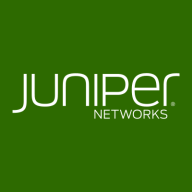

Ubiquiti UniFi Switches and Juniper QFX Series Switches are competitors in the network switch market. Ubiquiti seems to have the upper hand in cost-effectiveness for small to medium businesses due to its scalability and ease of use, while Juniper excels in advanced features suitable for large enterprises.
Features: Ubiquiti UniFi Switches offer centralized management, intuitive graphic interfaces, and cost-effective scalability. Users value ease of VLAN setup and firmware updates. Juniper QFX Series Switches are known for high-density ports, VxLAN, and EVPN features, which enhance network scalability and flexibility. These features make them suitable for enterprise-level networks requiring robust performance.
Room for Improvement: Ubiquiti UniFi Switches need better security features, centralized console management, and improved documentation. Limited visibility and high licensing fees pose further challenges for users, along with issues in product availability and support limitations. Juniper QFX Series Switches struggle with high costs and complex interfaces that demand a steep learning curve. Integration within data center architectures and the need for dedicated fiber connectivity also require attention.
Ease of Deployment and Customer Service: Ubiquiti UniFi Switches provide hybrid, public, and on-premises deployments, offering flexibility, yet customer service relies heavily on community support. Users report moderate tech support satisfaction. Juniper QFX Series Switches are typically used in on-premises settings, benefiting from structured manufacturer support channels, although these are less frequently utilized.
Pricing and ROI: Ubiquiti UniFi Switches are considered cost-effective, with advantages such as no recurring licensing costs and significant ROI through user-friendly setups that reduce deployment time. In contrast, Juniper QFX Series Switches, while equipped with high-end features, require a higher upfront cost and additional licensing fees, affecting cost-effectiveness and ROI compared to Ubiquiti.
Other brands might break after three or four years, but with Juniper, I can use it until now, around nine years, and it's still very usable and very stable.
The normal ROI customers work with is five years unless there is a major change in technology.
Another solution offered to us was more than double the price, making UniFi a cost-effective choice.
We saw a return on investment within a year, although I believe there's more potential to be leveraged.
The technical support of Juniper is very helpful because if we have some big issues, we can raise P1 or P2 tickets, and the response from Juniper is very fast.
Sometimes parts are not available in stock, then you have to wait for replacement time.
The team is knowledgeable and efficient.
the manuals, installation videos, and resources on the website are very good and straightforward.
They have a large customer base that sometimes faces issues due to a lack of know-how in managing the devices.
When building a fabric, you can add multiple leaf switches and multiple spine switches if required.
I rate the scalability as nine out of ten.
If planning for future scalability, choosing switches that support extra modules for fiber optics is advisable.
The solution is sufficiently scalable because the switches can be stacked.
Juniper has better performance than any other networking product as far as performance is concerned in the router area.
I did not experience any problems the whole year.
We have never experienced any problems with Ubiquiti UniFi Switches as they are consistently stable.
The switches are stable and there have been no outages.
My personal opinion is that if anyone wants to work with a Layer 3 fabric in a data center, they should choose Juniper because working with ACI and APIC is very complex in the Cisco part.
I would like to see other cheaper plans for the license on the QFX series.
The current setup is closed and does not allow for integration with non-Ubiquiti VoIP devices or providers outside their ecosystem.
Recent updates have removed many options available in earlier versions, simplifying the interface but limiting control.
The choice depends on the network architecture and planning for the future scalability requirements.
We are a number one, tier-one partner of Juniper. Therefore, we normally get better discounts than with Cisco because we don't have the level one partnership with Cisco.
Many vendors mark up prices significantly.
Pricing is very favorable, with minimal licensing involved.
Our investment in Ubiquiti is about £30,000, and it's a cost-effective solution since there is no subscription fee.
They are easy to use and flexible to deploy in any kind of environment.
The best feature of Juniper QFX Series Switches is the virtual chassis feature because it's very stable in my experience.
I can manage user connectivity, limit bandwidth, apply MAC address filtering, and it offers POE capabilities.
The switches enable management from anywhere using the cloud controller, making configuration changes and management easier.
I was involved in Kenya's last general elections where we used Ubiquiti equipment, both wireless and switching, which performed excellently.
| Product | Market Share (%) |
|---|---|
| Ubiquiti UniFi Switches | 7.7% |
| Juniper QFX Series Switches | 0.4% |
| Other | 91.9% |


| Company Size | Count |
|---|---|
| Small Business | 5 |
| Midsize Enterprise | 1 |
| Large Enterprise | 2 |
| Company Size | Count |
|---|---|
| Small Business | 45 |
| Midsize Enterprise | 8 |
| Large Enterprise | 1 |
QFX Series Switches deliver industry-leading throughput and scalability, an extensive routing stack, the open programmability of the Junos OS, and a broad set of EVPN-VXLAN and IP fabric capabilities. With QFX, you’ll find premier solutions for data center spine-and-leaf, campus distribution, core, and data center gateway and interconnect switching.
Rethink data center operations and fabric management with turnkey Juniper Apstra software in your QFX Series environment. You can automate the entire network lifecycle to simplify design and deployment and provide closed-loop assurance. With Apstra, customers have achieved 90% faster time to deployment, 70% faster time to resolution, and 83% OpEx reduction.
Ubiquiti UniFi Switches are managed Gigabit switches (Available with 24 or 48 RJ45 Gigabit ports) designed to meet all your network needs while delivering excellent performance. The switches’ excellent network performance is combined with fiber connectivity that includes two SFP ports and the ability to process traffic without putting packet loss at risk.
Ubiquiti UniFi Switches Are:
Ubiquiti UniFi Switches Support These Three Output Modes:
Ubiquiti UniFi Switches Support These Three Input Modes:
Ubiquiti UniFi Switches Features:
Benefits of Ubiquiti UniFi Switches:
Reviews from Real Users
A PeerSpot user who is a Director of Technical Operations/CTO at a consultancy says "The ability to deploy quickly and then having one central location for all the settings are its most valuable aspects."
"The integration with the controller is one of the most valuable features of these switches. They are also very stable. For example, we have some equipment that we haven't touched for four years that is still reliable," says Doru I., Senior solutions architect at Aplix Technologies
Murali S., Management Consultant at a consultancy, explains that “For the world where you have to balance traffic and traffic loads and bandwidth, their GUI makes it really easy because the switches, though they are enterprise grade level two or level three switches, the GUI is designed so that it's easy to set up VLANs where you need to control your traffic so that your phones don't break up and get choppy because of other people loading the network down too heavily."
We monitor all Ethernet Switches reviews to prevent fraudulent reviews and keep review quality high. We do not post reviews by company employees or direct competitors. We validate each review for authenticity via cross-reference with LinkedIn, and personal follow-up with the reviewer when necessary.